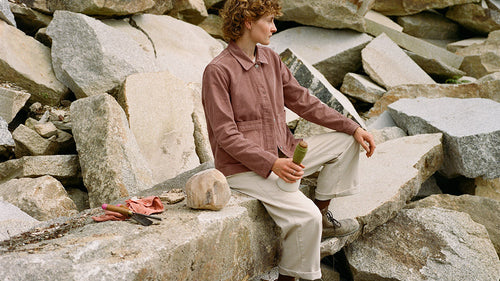Our friend Dewi has embarked on a major project in the last year. He's set up Combine, a future farm for creativity, a space to bridge the gap between urban and rural, helping to direct new possibilities of what farming can be.
Dewi is all about process-driven design with a focus on people, place and materials. He's literally ploughing all the knowledge he's built from growing up on a farm in West Wales into his Grandparent's old farm that he moved into in Summer 2018. His big goal above all others is to bring together farming and design communities, creating a physical space where work can be done and where ideas can form. Two tribes often separated from each other by rural and urban divides, brought closer together at Combine, looking forward to the creative potential of rural spaces.
We chatted to Dewi about the ideas behind Combine, the home of our shoot for Batch No. 1, where every single photo on our website was taken.
Where is combine, and how did you end up there?
The farm is approx 40 minutes on the Thameslink south of London Bridge. My grandparents lived and farmed here, and my father was born and raised on the 400acre tenant farm. As a family, we have cultivated here for 60 years.
A year ago I moved back to my late grandfather's farm, relocating from London after studying Design at Goldsmiths University, they definitely played a huge role to helping to push me to make the jump.

Tell us more about your plans for the 'Future Farm'
My ambition with Combine is to see more designers work with farmers, sharing ideas to help think of new by-products and new modes of working to ensure that farming remains profitable but exciting too. The idea of bridging the urban and rural together is predominately to construct one big community who can share space, tools and knowledge which will tie back to where farming as a profession is heading.
I hope Combine can expose what farming as a practice is, educating people about the procedure of what harvesting and growing means but also aiding creatives to get involved and help direct the possibilities for new forms of what farming can be.
Right now, Combine is an arable farm, growing the standard wheat, oats and barley, but since moving to the farm I have introduced a new herd to it – people. Combine is a farm space using the derelict barns which are currently impractical for farming practices due to the age and scale of the structures, but perfect to host events, workshops and studio spaces.
You can stay tuned to events coming up, and news from Combine here (don't expect a newsletter that will flood your inbox, when Dewi isn't busy working on the farm he's working at Makerversity in London. So he'll be in touch sporadically, with updates of where Combine is headed).

Early brand identity work by Harry Ingrams for Combine

CNC'ing the Combine logo ready for early creative workshops at Combine
How did you get into design?
My understanding of Design began with my rural upbringing on a farm, and later shaped by my education in an urban location; so I try and explain my practice today as a mixture of both the farmer and designer as one.

So that's where the idea from Combine came from?
Yeah, Combine stems from a project I designed at Goldsmiths, called 'The Baler'.
The Baler (ˈbeɪlə)
Noun
Noun: baler; plural nouns: balers
A tool that communicates, a tool which travels, a tool that can collect data, wrapping it too. A tool which would bale my outcome as a designer.
The Baler explores the relationship between the urban and the rural, identifying objects and spaces which play an important role in both environments. I began the project by focussing on the sheep pen as a material metaphor, using it to facilitate workshops across London bringing structures of the rural into the urban environment. In the process, I recognised the urban design studios and workshops, specifically so-called Fabrication Laboratories (Fab Labs), as critical spaces where designers develop their practice, noticing the potential synergy between farm workshops and design studios.
Identifying these spaces as layering the farm and the city, I found similarity in the 3D Printer and the baler, in that both perform repetitive tasks with material inputs and outputs, collecting material and transforming it into shaped objects, then distributing it across territories.

In response, I designed The Baler, a tool that is taken for walks through London by an operator and a partner. It's designed to collect material data from the floor while at the same time to acting as a site of human data, recording conversations about the relationship between the urban and the rural.
As The Baler covers more ground and more conversations are baled, I continue my continual questioning of the future of the rural and its potentialities as new creative spaces. So, that's what led me to Combine.

All photos for Batch No.1 were taken here at Combine, using only an iPhone by Dan Rubin.
You can follow daily Dewi's adventures via Instagram, and more of his work on his blog, Design Donkey.



